Tourism Knowledge Domains of Chinese and International Research
Abstract
1. Introduction
- What are the characteristics of the international tourism research knowledge domain?
- What are the characteristics of the Chinese tourism research knowledge domain?
- What are the differences in the characteristics of the Chinese and international tourism research knowledge domains?
- What are the reasons for the differences between the Chinese and international tourism research?
2. Literature Review
2.1. Analysis of the Progress of Tourism Research
2.1.1. Analysis of the Progress of International Tourism Research
2.1.2. Analysis of the Progress of Chinese Tourism Research
2.2. Research on Tourism Knowledge Domains
2.2.1. Research on the International Tourism Knowledge Domain
2.2.2. Research on the Chinese Tourism Knowledge Domain
2.3. Research on Comparison of Chinese and International Tourism Research
3. Materials and Methods
3.1. Data Collection
3.2. Data Processing
3.3. Data Overview
3.4. Data Coding and Analysis
4. Results
4.1. Analysis of Chinese Tourism Research Knowledge Domain
4.1.1. Overview of Chinese Tourism Research Knowledge Domain
4.1.2. Geographical Analysis of Chinese Tourism Research
4.1.3. Analysis of Research Objects in Chinese Tourism Research
4.1.4. Analysis of Research Methods and Theories in Chinese Tourism Research
4.1.5. Analysis of Research Disciplines in Chinese Tourism Research
4.2. Analysis of International Tourism Research Knowledge Domain
4.2.1. Overview of International Tourism Research Knowledge Domain
4.2.2. Geographical Analysis of International Tourism Research
4.2.3. Analysis of Research Objects in International Tourism Research
4.2.4. Analysis of Research Methods and Theories in International Tourism Research
4.2.5. Analysis of Research Disciplines in International Tourism Research
4.3. Comparative Analysis of Chinese and International Tourism Research Knowledge Domains
4.3.1. Comparative Analysis of All Keywords in Chinese and International Tourism Research
4.3.2. Comparative Analysis of Geographic Areas in Chinese and International Tourism Research
4.3.3. Comparative Analysis of Research Objects in Chinese and International Tourism Research
4.3.4. Comparative Analysis of Research Methods in Chinese and International Tourism Research
4.3.5. Comparative Analysis of Research Disciplines in Chinese and International Tourism Research
4.4. Timeline Map and Emergent Keyword Analysis of Chinese and International Tourism Research
4.4.1. Timeline Map and Emergent Keyword Analysis of Chinese Tourism Research
4.4.2. Timeline Map and Emergent Keyword Analysis of International Tourism Research
4.4.3. A Comparative Analysis of Chinese and International Tourism Research Progress
5. Discussion and Conclusions
6. Research Prospect
Author Contributions
Funding
Institutional Review Board Statement
Informed Consent Statement
Data Availability Statement
Conflicts of Interest
References
- Peng, K.J.; He, X.R. Research hotspots of China’s “Tourism Science” in the past two decades: Visual analysis based on the scientific knowledge map. Gen. Virtual Econ. Res. 2020, 11, 21–31. [Google Scholar]
- Zenker, S.; Kock, F. The coronavirus pandemic–A critical discussion of a tourism research agenda. Tour. Manag. 2020, 81, 104164. [Google Scholar] [CrossRef]
- Bao, J.G.; Huang, S.S.; Chen, G.H. Forty years of China tourism research: Reflections and prospects. J. China Tour. Res. 2019, 15, 283–294. [Google Scholar] [CrossRef]
- Feng, L.; Shi, P.H.; Liu, J.F. The 30-year history and regularity of Chinese tourism research based on the time series characteristics of journal articles. Geogr. Sci. Prog. 2011, 30, 239–248. [Google Scholar]
- Liu, L.; Wang, Z. 40 Years of Chinese Tourism Research: Reflections and Prospects—Summary of the 2017 “Tourism Tribune” China Tourism Research Annual Conference. Tour. Trib. 2017, 32, 128–132. [Google Scholar] [CrossRef]
- Wu, Q.H.; Su, X.B. Written talks on China’s tourism development—The COVID-19 and global tourism stagnation. Tour. Trib. 2020, 35, 1–3. [Google Scholar] [CrossRef]
- Xie, Y.J.; Na, M.F. The Theoretical Development and Role Evolution in the 40 Years of Research on Chinese Tourism. Tour. Trib. 2019, 34, 13–15. [Google Scholar] [CrossRef]
- Soliman, M.; Lyulyov, O.; Shvindina, H.; Figueiredo, R.; Pimonenko, T. Scientific output of the European Journal of Tourism Research: A bibliometric overview and visualization. Eur. J. Tour. Res. 2021, 28, 2801. [Google Scholar] [CrossRef]
- Hall, C.M. Publish and perish? Bibliometric analysis, journal ranking and the assessment of research quality in tourism. Tour. Manag. 2011, 32, 16–27. [Google Scholar] [CrossRef]
- Mokhtari, H.; Soltani-Nejad, N.; Mirezati, S.Z.; Saberi, M.K. A bibliometric and altmetric analysis of Anatolia: 1997–2018. Anatolia 2020, 31, 406–422. [Google Scholar] [CrossRef]
- Tian, Y.E.; Lee, H.A.; Law, R. A comparison of research topics in leading tourism journals. Int. J. Tour. Sci. 2011, 11, 108–126. [Google Scholar] [CrossRef]
- Ballantyne, R.; Packer, J.; Axelsen, M. Trends in tourism research. Ann. Tour. Res. 2009, 36, 149–152. [Google Scholar] [CrossRef]
- Wilson, E.; Mura, P.; Sharif, S.P.; Wijesinghe, S.N. Beyond the third moment? Mapping the state of qualitative tourism research. Curr. Issues Tour. 2020, 23, 795–810. [Google Scholar] [CrossRef]
- Li, J.; Xu, Y. Author analyses of tourism research in the past thirty years—Based on ATR, JTR and TM. Tour. Manag. Perspect. 2015, 13, 1–6. [Google Scholar] [CrossRef]
- Merigó, J.M.; Mulet-Forteza, C.; Martorell, O.; Merigó-Lindahl, C. Scientific research in the tourism, leisure and hospitality field: A bibliometric analysis. Anatolia 2020, 31, 494–508. [Google Scholar] [CrossRef]
- Xiao, H.; Smith, S.L. Source knowledge for tourism research. Ann. Tour. Res. 2005, 32, 272–275. [Google Scholar] [CrossRef]
- Tribe, J.; Liburd, J.J. The tourism knowledge system. Ann. Tour. Res. 2016, 57, 44–61. [Google Scholar] [CrossRef]
- Xiao, H.; Smith, S.L. The making of tourism research: Insights from a social sciences journal. Ann. Tour. Res. 2006, 33, 490–507. [Google Scholar] [CrossRef]
- Mulet-Forteza, C.; Lunn, E.; Merigó, J.M.; Horrach, P. Research progress in tourism, leisure and hospitality in Europe (1969–2018). Int. J. Contemp. Hosp. Manag. 2021, 33, 48–74. [Google Scholar] [CrossRef]
- Qian, J.; Shen, H.; Law, R. Research in sustainable tourism: A longitudinal study of articles between 2008 and 2017. Sustainability 2018, 10, 590. [Google Scholar] [CrossRef]
- Singh, R. The state of Indian tourism and hospitality research: A review and analysis of journal publications. Tour. Manag. Perspect. 2016, 17, 90–99. [Google Scholar] [CrossRef]
- Correia, A.; Kozak, M. Past, present and future: Trends in tourism research. Curr. Issues Tour. 2022, 25, 995–1010. [Google Scholar] [CrossRef]
- Airey, D. 40 years of tourism studies–a remarkable story. Tour. Recreat. Res. 2015, 40, 6–15. [Google Scholar] [CrossRef]
- Ryan, C. Future trends in tourism research–Looking back to look forward: The future of ‘Tourism Management Perspectives’. Tour. Manag. Perspect. 2018, 25, 196–199. [Google Scholar] [CrossRef]
- Niñerola, A.; Sánchez-Rebull, M.V.; Hernández-Lara, A.B. Tourism research on sustainability: A bibliometric analysis. Sustainability 2019, 11, 1377. [Google Scholar] [CrossRef]
- Yu, L.; Wang, G.; Marcouiller, D.W. A scientometric review of pro-poor tourism research: Visualization and analysis. Tour. Manag. Perspect. 2019, 30, 75–88. [Google Scholar] [CrossRef]
- Koseoglu, M.A.; Rahimi, R.; Okumus, F.; Liu, J. Bibliometric studies in tourism. Ann. Tour. Res. 2016, 61, 180–198. [Google Scholar] [CrossRef]
- Bao, J.G.; Chen, G.H.; Ma, L. Tourism research in China: Insights from insiders. Ann. Tour. Res. 2014, 45, 167–181. [Google Scholar] [CrossRef]
- Zhang, L.; Lan, C.; Qi, F.; Wu, P. Development pattern, classification and evaluation of the tourism academic community in China in the last ten years: From the perspective of big data of articles of tourism academic journals. Tour. Manag. 2017, 58, 235–244. [Google Scholar] [CrossRef]
- Sun, Y.; Wei, Y.; Zhang, L.Y. International academic impact of Chinese tourism research: A review based on the analysis of SSCI tourism articles from 2001 to 2012. Tour. Manag. 2017, 58, 245–252. [Google Scholar] [CrossRef]
- Huang, S.S.; Chen, G.H. Tourism Research in China: Themes and Issues; Channel View Publications: Bristol, UK, 2015; pp. 130–142. ISBN 978-184-541-547-1. [Google Scholar]
- Zhang, L.Y.; Qiao, X.J.; Chen, Y.Y.; Qian, H. Evaluation of the International Influence of China’s Tourism Academic Research—Based on the Statistical Research of SSCI Tourism Papers from 2001 to 2019. Tour. Trib. 2020, 35, 123–135. [Google Scholar] [CrossRef]
- Zhang, L.Y.; Zhang, D.; Zhang, Y.X.; Zhou, X.Y.; Wang, C.J. Research on the International Influence of China’s Tourism Academic Papers—Based on the Statistics of Tourism SSCI Papers from 2001 to 2017. Tour. Trib. 2018, 33, 121–133. [Google Scholar] [CrossRef]
- Zhang, L.Y.; Jin, J.; Wei, Y.J.; Sun, Y.H. Research on the international influence of Chinese tourism research: Based on the statistical analysis of Chinese Scholars’ SSCI papers from 2001 to 2014. Tour. Trib. 2016, 31, 33–44. [Google Scholar] [CrossRef]
- Sun, Y.H.; Wei, Y.J.; Zhang, L.Y. Analysis of the International influence of Chinese tourism research: Based on the statistics of papers in core journals of tourism at Chinese and foreign from 2001 to 2012. Tour. Trib. 2013, 28, 118–128. [Google Scholar] [CrossRef]
- Lan, C.Y.; Zhang, L.Y. Research on the influence and influence factor of Chinese tourism academic journals. Tour. Trib. 2013, 28, 96–105. [Google Scholar] [CrossRef]
- Niu, Y.; Wang, D.G.; Qian, J. Influence analysis of tourism literature based on high citation frequency. Tour. Trib. 2014, 29, 114–124. [Google Scholar] [CrossRef]
- Liu, R. A review of domestic and foreign tourism research. Tour. Trib. 2015, 30, 110–117. [Google Scholar] [CrossRef]
- Zhang, L.Y.; Han, L.; Zhang, Y.; Zhou, X.; Zhang, S. Academic evaluation of Chinese tourism academic community from 2003 to 2018. Tour. Trib. 2019, 34, 120–136. [Google Scholar] [CrossRef]
- Zhang, L.Y.; Qi, F.; Huang, X.B.; Huang, Y.T.; Zhang, Y.K. Evaluation of Chinese tourism academic journals and academic papers from 2003 to 2014. Tour. Trib. 2015, 30, 85–100. [Google Scholar] [CrossRef]
- Zhang, C.Z. Qualitative tourism research: Expression norms and reflections—Based on the analysis of articles in the Tourism Tribune from 2000 to 2013. Tour. Trib. 2017, 32, 89–98. [Google Scholar] [CrossRef]
- Zhang, L.Y.; Qi, F.; Wu, P. The h-index measurement and evaluation of the achievements of my country’s tourism academic community in the past ten years. Tour. Trib. 2014, 29, 14–23. [Google Scholar] [CrossRef]
- Liu, J.; Ren, Z.W.; Wang, S.H.; Li, Y.Y.; Zhu, J.H.; Chen, F.; Wang, L.N. The characteristics and regulations of international tourism research trends: Based on the analysis of documents collected by Web of Science from 1985 to 2015. Tour. Trib. 2019, 34, 125–133. [Google Scholar] [CrossRef]
- Liu, J.; Li, Y.Y. Review and enlightenment of tourism research based on social network theory at Chinese and foreign. Resour. Dev. Mark. 2016, 32, 1134–1138. [Google Scholar] [CrossRef]
- Liu, H.; Lei, B. A review of tourism research at Chinese and foreign based on web text analysis. Chin. Foreign Entrep. 2018, 30, 59–60. [Google Scholar]
- Li, C.; Zhao, J. Visualization analysis of tourism management research information based on Web of Science. Tour. Trib. 2014, 29, 104–113. [Google Scholar] [CrossRef]
- Xie, Y.J. Tourism and hospitality industry studies: A comparative study between China and the overseas counties. Tour. Trib. 2003, 18, 20–25. [Google Scholar]
- Yu, G.X.; Dai, G.Q. Tourism discipline innovation and construction of knowledge system based on keyword quantitative analysis of “Tourism Tribune”. Tour. Trib. 2017, 32, 99–110. [Google Scholar] [CrossRef]
- Wang, D.G.; Li, F.; Xu, Y.F.; Niu, Y. The characteristics and trends of Chinese tourism research based on the 30-year history of “Tourism Tribune”. Tour. Trib. 2018, 33, 133–146. [Google Scholar] [CrossRef]
- Dong, X.L.; Wu, B.H.; Zhong, L.N. Analysis of Chinese tourism research knowledge system based on keyword analysis of “Tourism Tribune”. Tour. Trib. 2011, 26, 26–31. [Google Scholar]
- Li, Q.Y.; Han, G.S.; Zhang, A.P.; Xu, H. Bibliometric and content analysis of Chinese tourism geography from 1979 to 2012. Tour. Trib. 2014, 29, 110–119. [Google Scholar] [CrossRef]
- Zhang, L.Y.; Lan, C.Y.; Qi, F.; Wu, P. The development pattern and classification evaluation of Chinese tourism academic community in the past ten years: Based on the perspective of big data in tourism academic journal papers. Tour. Trib. 2013, 28, 114–125. [Google Scholar] [CrossRef]
- Tang, S.Y. Analysis and prospect of doctoral dissertation in tourism in China in recent ten years. Tour. Trib. 2013, 28, 106–113. [Google Scholar] [CrossRef]
- Tao, H.; Wang, X.; Wu, X.G. Research progress of Chinese tourism from the perspective of funded projects in the past decade. J. Beijing Int. Stud. Univ. 2014, 229, 25–34. [Google Scholar]
- Li, J.L.; Fu, J.J. Twenty years of tourism research in China (1993–2013): Based on the academic situation reflected by the NSSFC tourism project. Resour. Dev. Mark. 2014, 30, 847–851. [Google Scholar] [CrossRef]
- Zhong, L.; Wu, B.H.; Morrison, A.M. Research on China’s tourism: A 35-year review and authorship analysis. Int. J. Tour. Res. 2015, 17, 25–34. [Google Scholar] [CrossRef]
- Tribe, J.; Xiao, H. Developments in tourism social science. Ann. Tour. Res. 2011, 38, 7–26. [Google Scholar] [CrossRef]
- Wickham, M.; Dunn, A. Analysis of the leading tourism journals 1999–2008. Ann. Tour. Res. 2012, 39, 1683–1724. [Google Scholar] [CrossRef]
- Wu, B.H.; Xiao, H.; Dong, X.L.; Wang, M.; Xue, L. Tourism knowledge domains: A keyword analysis. Asia Pac. J. Tour. Res. 2012, 17, 355–380. [Google Scholar] [CrossRef]
- Benckendorff, P.; Zehrer, A. A network analysis of tourism research. Ann. Tour. Res. 2013, 43, 121–149. [Google Scholar] [CrossRef]
- Xie, Y.J. A Probe into the Subject Issues of Tourism. J. Guilin Inst. Tour. 1999, S2, 11–14+47. [Google Scholar]
- Wu, Y.H. Literature analysis of “Chronicle of Tourism Research” and the discipline system of tourism. Tour. Sci. 2004, 18, 4–8+25. [Google Scholar] [CrossRef]
- Lian, T.H.; Yu, C.H.; Zong, Q.J.; Yuan, Q.J. Knowledge map analysis of tourism discipline research from 2000 to 2010 based on CSSCI. Tour. Trib. 2013, 28, 114–119. [Google Scholar] [CrossRef]
- Yu, G.X. Evolution and co-occurrence of foreign tourism research knowledge system. J. Tour. Manag. 2016, 551, 159–173. [Google Scholar] [CrossRef]
- Zhang, L.Y. Research on the current situation of tourism research in China and the construction of the discipline system. Tour. Sci. 2012, 26, 14–25. [Google Scholar] [CrossRef]
- Zhang, M.; Li, H.R.; Yang, X.S. Research on international tourism knowledge system: Themes, trends and frameworks—Based on a sample analysis of 11 international authoritative journals from 2005 to 2014. Tour. Trib. 2017, 32, 104–115. [Google Scholar] [CrossRef]
- Cheng, M.M. A cross-cultural comparison of East and Western academic literature on adventure tourism. Tour. Stud. 2018, 18, 357–374. [Google Scholar] [CrossRef]
- Hung, K.; Wang, S.; Guillet, B.D.; Liu, Z. An overview of cruise tourism research through comparison of cruise studies published in English and Chinese. Int. J. Hosp. Manag. 2019, 77, 207–216. [Google Scholar] [CrossRef]
- Xie, R.L.; Wu, B. An overview of religious tourism research in and outside China in the past 30 years. Tour. Trib. 2016, 31, 111–125. [Google Scholar] [CrossRef]
- Yan, M.; Zhao, Y. Overview of canal heritage tourism research at home and abroad. Resour. Dev. Mark. 2016, 32, 626–630. [Google Scholar] [CrossRef]
- Liu, H.; Yang, D.J.; Wang, H.Y. Comparison and future prospect of Marine tourism research at home and abroad. Resour. Dev. Mark. 2016, 32, 1398–1403. [Google Scholar] [CrossRef]
- Liu, Q.Y. Comparison of sports tourism research at home and abroad. J. Shanghai Phys. Educ. Inst. 2012, 36, 39–43. [Google Scholar] [CrossRef]
- Zhu, M.; Wei, X. Comparison and prospect of cultural tourism research at home and abroad. Prog. Geogr. 2014, 33, 1262–1278. [Google Scholar] [CrossRef]
- Liu, J.G.; Zhang, Y.J. Medical tourism: A review of domestic and international literature and research prospects. Tour. Trib. 2016, 31, 113–126. [Google Scholar] [CrossRef]
- He, J.M. Rural Tourism Research between China and Western countries: Comparison, reflection and Prospect. Rural Econ. 2005, 1, 126–127. [Google Scholar]
- He, L.C. A review of ecotourism literature at home and abroad in the past two decades. Tour. Overv. 2016, 3, 236–237. [Google Scholar]
- Li, J. Map Analysis of the Progress of Tourism Interpretation Research: Based on the Measurement Comparison of Chinese and International Literature. MATEC Web Conf. 2019, 267, 04004. [Google Scholar] [CrossRef]
- Sun, X.; Wang, X.; Liu, D.L.; He, J. The comparison of domestic and foreign research topics on tourism poverty alleviation based on the perspective of social network analysis. Resour. Dev. Mark. 2017, 33, 1396–1402. [Google Scholar] [CrossRef]
- Liu, A.L.; Liu, F.C.; Liu, M.; Deng, Z.Y. Research progress of tourism soundscape at home and abroad. Tour. Trib. 2016, 31, 114–126. [Google Scholar] [CrossRef]
- Li, J.; Lu, Y.T. Chinese culture in tourist research: A review and comparison of Chinese and English studies in 1993–2012. Tour. Rev. 2016, 71, 118–134. [Google Scholar] [CrossRef]
- Zhu, H.; Liu, Y.H. Viewing the difference and trend of Chinese and foreign tourism research by comparing the articles published on “Tourism Tribune” and “Annals of Tourism Research”. Tour. Trib. 2004, 19, 92–95. [Google Scholar]
- Wang, D.G.; Chen, T.; Wang, J.L.; Liu, C.X. Comparison of domestic and foreign tourism research from 1980 to 2009. J. Geogr. Sci. 2011, 66, 535–548. [Google Scholar]
- Xu, Y. Analysis of the Pattern of Tourism Research at Home and Abroad. Ph.D. Thesis, Anhui University, Hefei, China, 2016. [Google Scholar]
- Cheng, C.K.; Li, X.R.; Petrick, J.F.; O’Leary, J.T. An examination of tourism journal development. Tour. Manag. 2011, 32, 53–61. [Google Scholar] [CrossRef]
- Huang, S.S.; Chen, G.H.; Luo, X.R.; Bao, J.G. Evolution of tourism research in China after the millennium: Changes in research themes, methods, and researchers. J. China Tour. Res. 2019, 15, 420–434. [Google Scholar] [CrossRef]
- Huang, S.S.; Chen, G.H. Current state of tourism research in China. Tour. Manag. Perspect. 2016, 20, 10–18. [Google Scholar] [CrossRef]
- Gursoy, D.; Sandstrom, J.K. An updated ranking of hospitality and tourism journals. J. Hosp. Tour. Res. 2016, 40, 3–18. [Google Scholar] [CrossRef]
- Napierała, T.; Leśniewska-Napierała, K.; Al-Rawhani, M.; Bayramdurdyyev, R.; Bugaj, H.; Cetin, A.; Gonzalvo, J. Sustainability of studies on sustainable tourism–a bibliometric approach. Eur. Spat. Res. Policy 2022, 29, 41–58. [Google Scholar] [CrossRef]
- Ruhanen, L.; Weiler, B.; Moyle, B.D.; McLennan, C.L.J. Trends and patterns in sustainable tourism research: A 25-year bibliometric analysis. J. Sustain. Tour. 2015, 23, 517–535. [Google Scholar] [CrossRef]
- Mauleon-Mendez, E.; Genovart-Balaguer, J.; Merigo, J.M.; Mulet-Forteza, C. Sustainable tourism research towards twenty-five years of the Journal of Sustainable Tourism. Adv. Hosp. Tour. Res. 2018, 6, 23–46. Available online: http://hdl.handle.net/10453/132474 (accessed on 14 March 2021). [CrossRef]
- Wang, Q.; Zhang, Y.F.; Yang, G.H. Knowledge graph of Chinese national park recreation utilization research based on CiteSpace. Tour. Res. 2021, 13, 71–84. [Google Scholar] [CrossRef]
- Yang, Y.; Xu, X. Research on the academic influence and discipline development of tourism researchers in China: Statistical analysis based on CNKI tourism academic papers. Tour. Trib. 2017, 32, 103–115. [Google Scholar] [CrossRef]
- Zhang, L.Y.; Wang, C.J.; Zhang, D.; Han, L.; Zhang, Y.X. Academic evaluation of Chinese tourism academic community from 2003 to 2016. Tour. Trib. 2017, 32, 117–127. [Google Scholar] [CrossRef]
- Roberts, C.; Reynolds, J.; Dolasinski, M.J. Meta-Analysis of Tourism Sustainability Research: 2019–2021. Sustainability 2022, 14, 3303. [Google Scholar] [CrossRef]


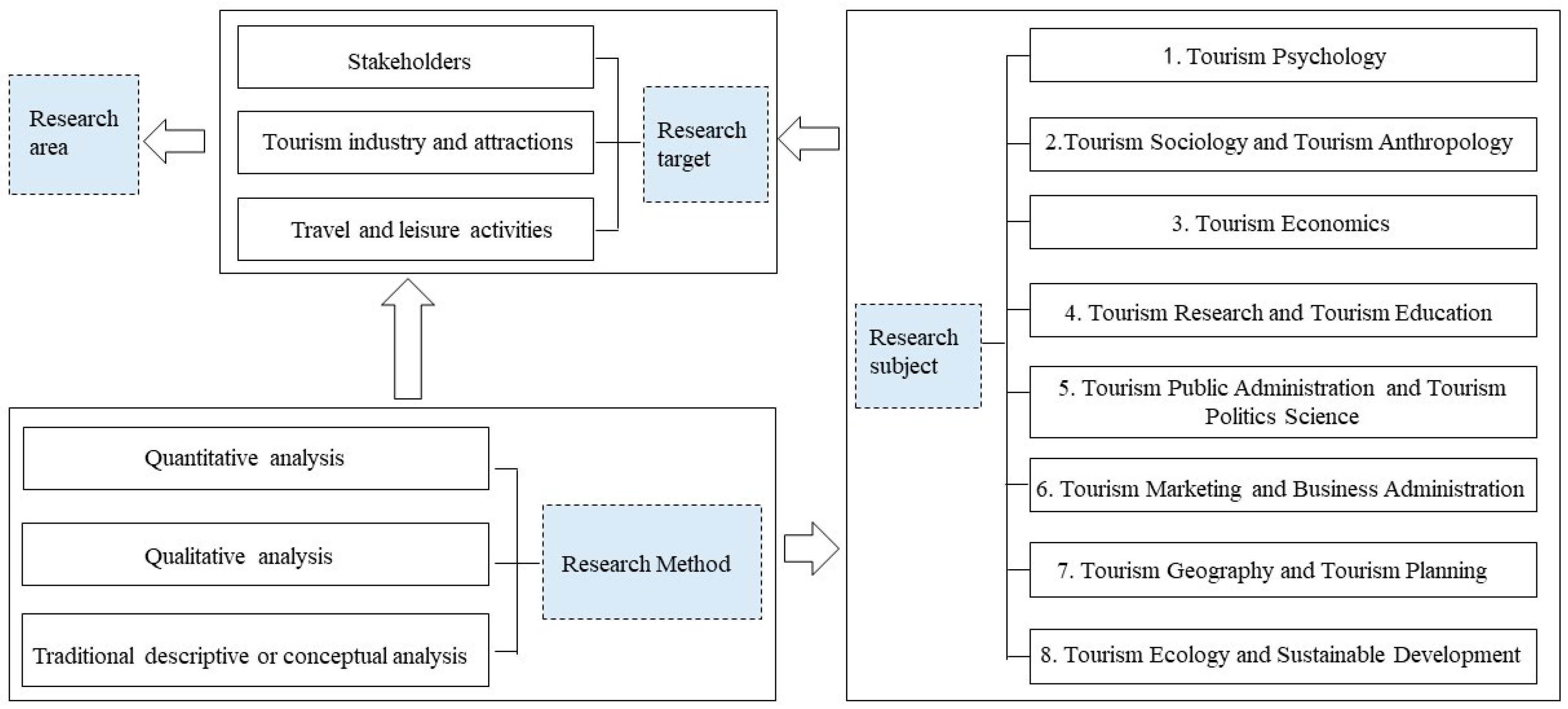
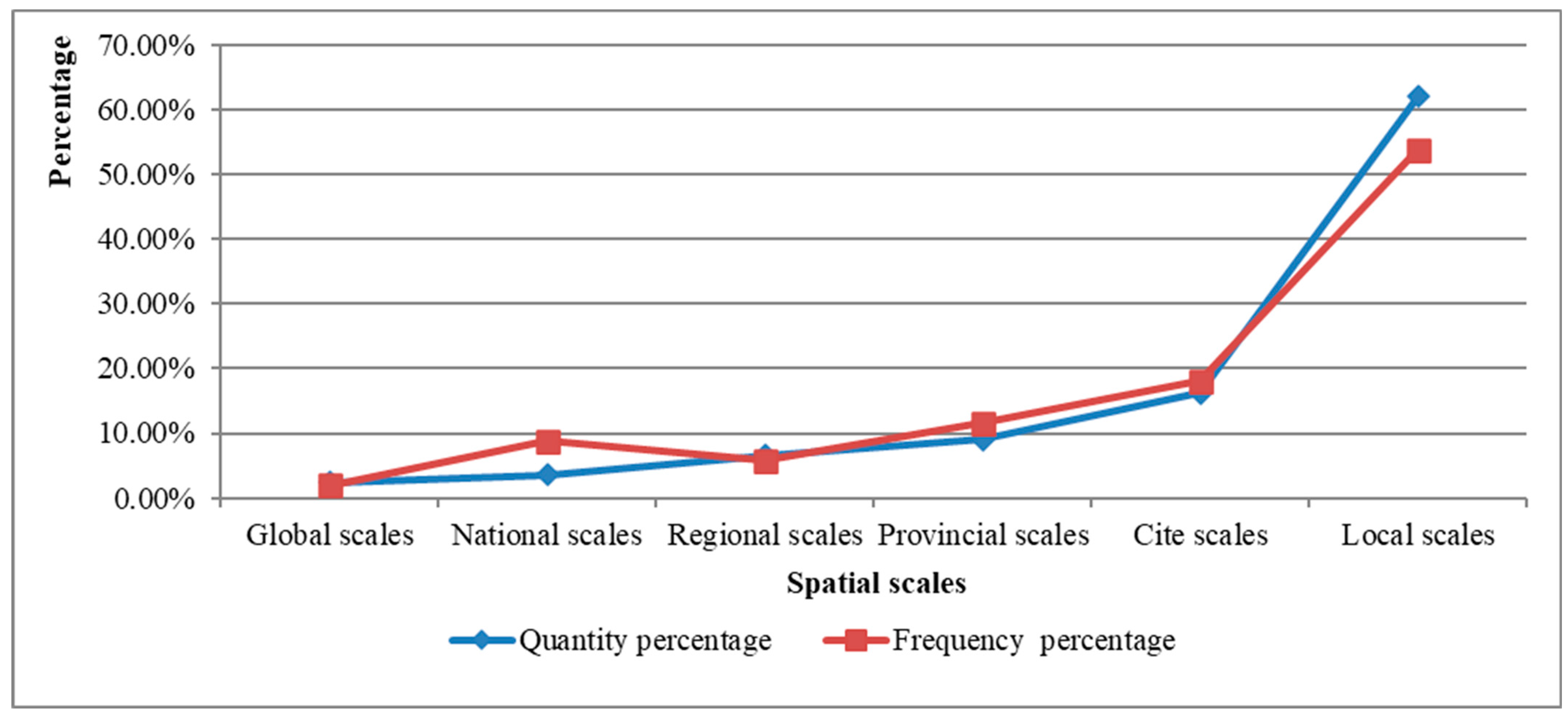
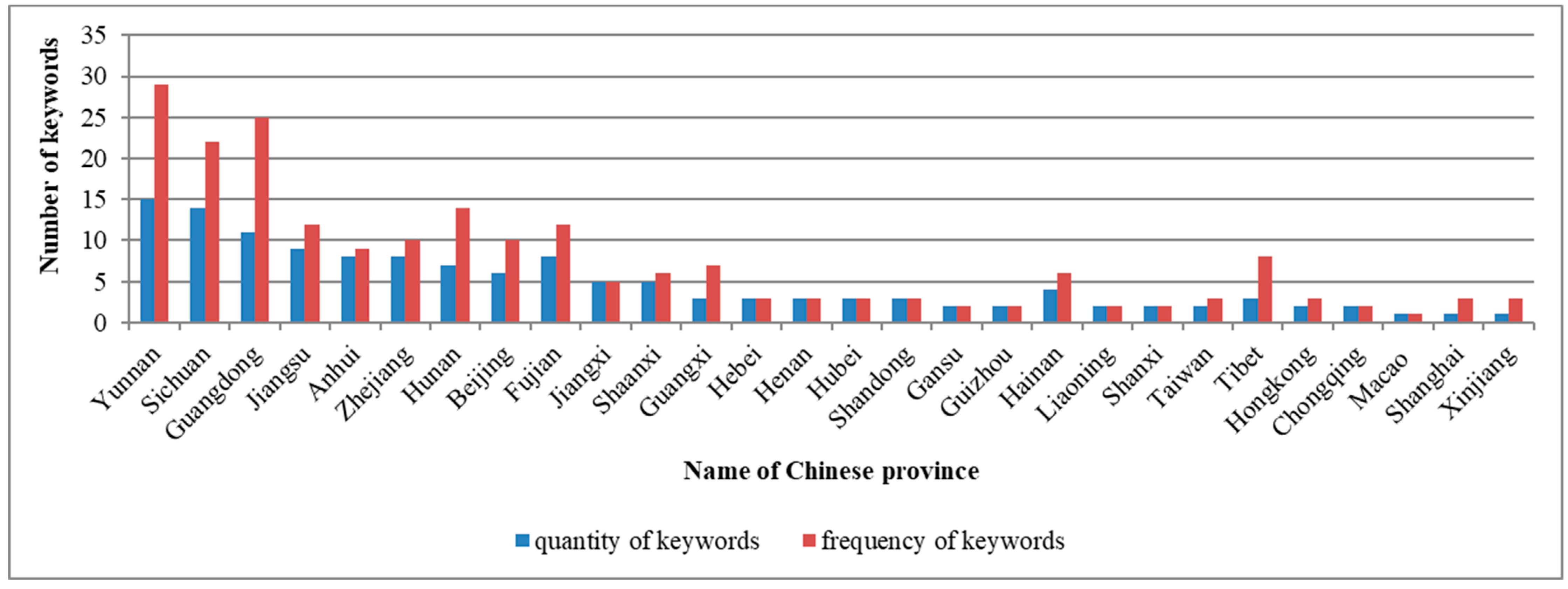
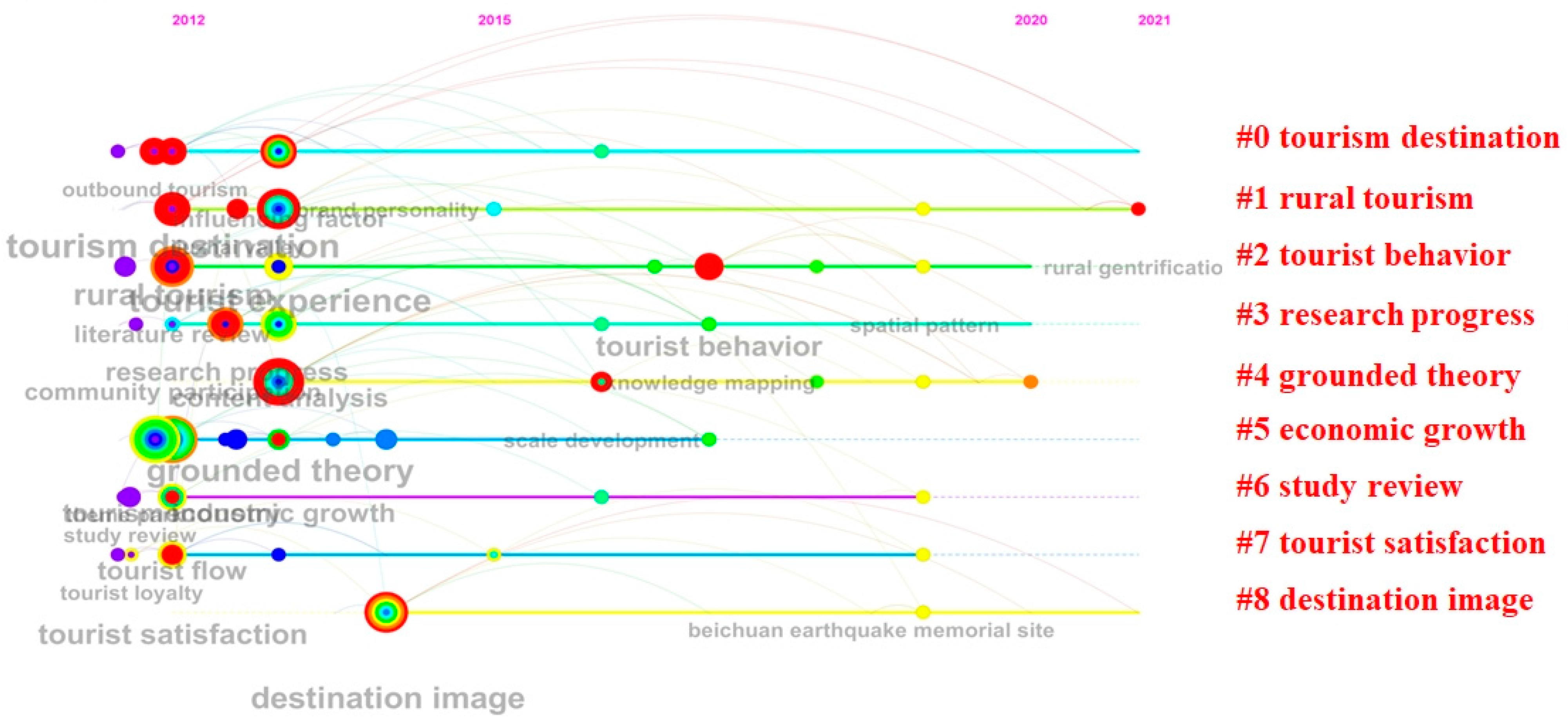
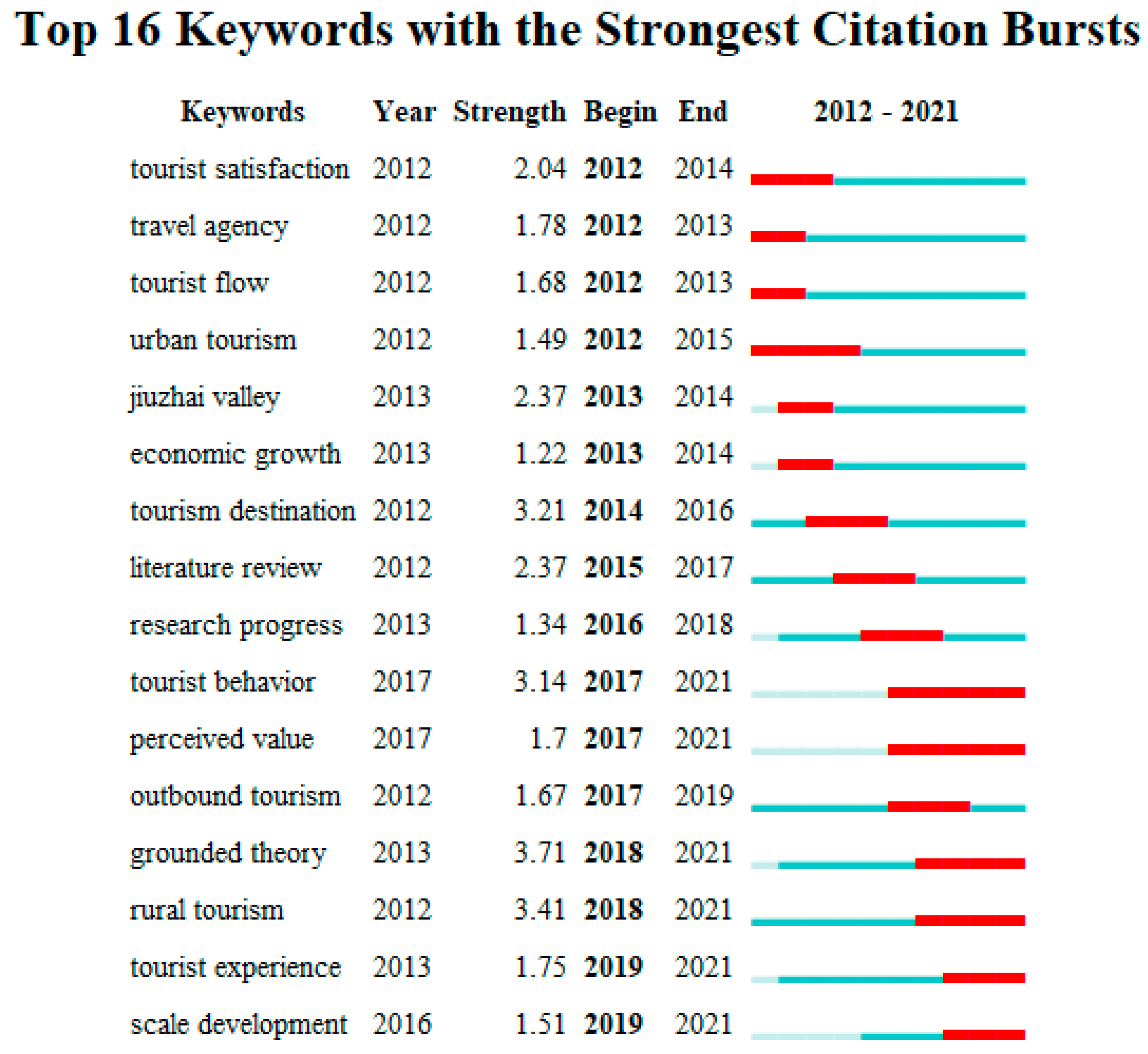
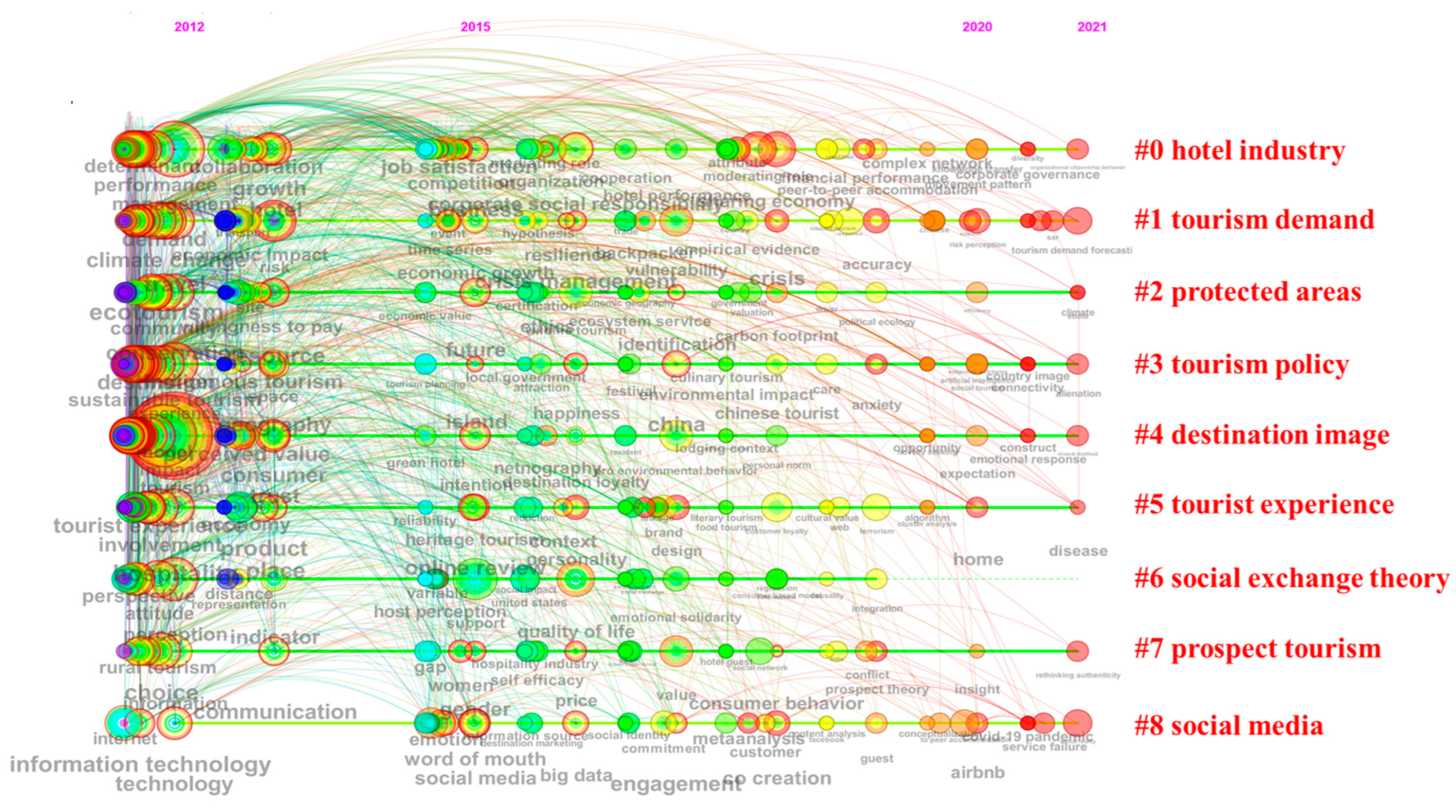
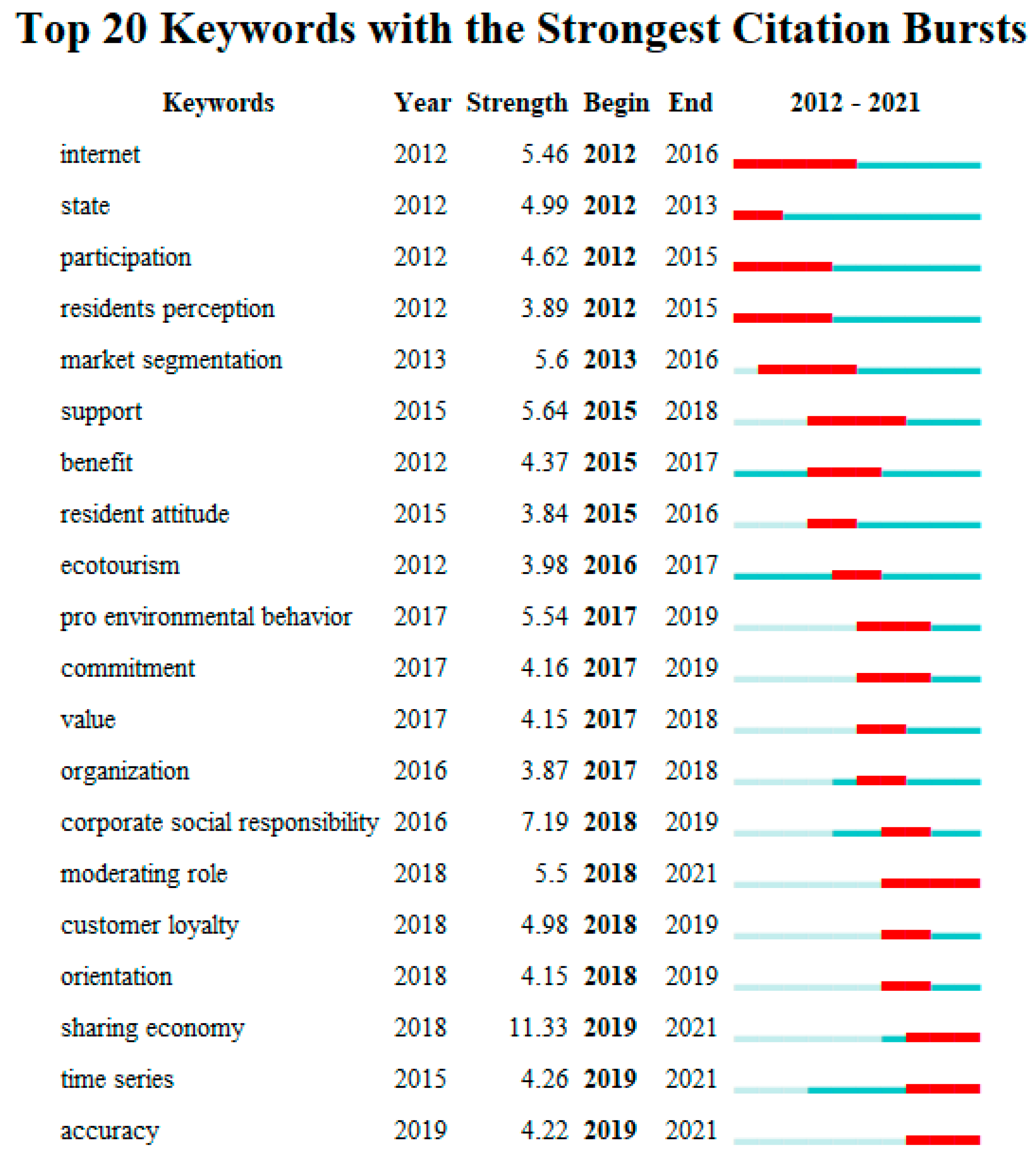
| Journals | Annals of Tourism Research | Tourism Management | Journal of Sustainable Tourism | Tourism Tribune |
|---|---|---|---|---|
| Start of publication | 1973 | 1974 | 1989 | 1986 |
| Years analyzed | 10 (2012–2021) | 10 (2012–2021) | 10 (2012–2021) | 10 (2012–2021) |
| Number of articles | 804 | 1901 | 879 | 1204 |
| Number of keywords | 4028 | 9874 | 4681 | 5132 |
| Average number of keywords | 5.01 | 5.194 | 5.325 | 4.262 |
| Keywords | Quantity | Quantity Percentage (%) | Frequency | Frequency Percentage (%) | Average Frequency | Frequency Variance |
|---|---|---|---|---|---|---|
| Tourism marketing and business administration | 511 | 14.77 | 669 | 13.04 | 1.31 | 0.83 |
| Tourism sociology and tourism anthropology | 452 | 13.07 | 592 | 11.54 | 1.31 | 1.21 |
| Tourism public administration and tourism politics | 444 | 12.84 | 553 | 10.78 | 1.25 | 0.48 |
| Tourism psychology and tourist behavior | 395 | 11.42 | 602 | 11.73 | 1.52 | 3.74 |
| Tourism geography and tourism planning | 365 | 10.55 | 518 | 10.09 | 1.42 | 2.83 |
| Tourism research and tourism education | 309 | 8.93 | 482 | 9.39 | 1.56 | 4.05 |
| Research method | 236 | 6.82 | 406 | 7.91 | 1.72 | 7.13 |
| Research area | 166 | 4.80 | 260 | 5.07 | 1.57 | 3.11 |
| Tourism industry and attractions | 153 | 4.42 | 297 | 5.79 | 1.94 | 11.06 |
| Tourism economics | 146 | 4.22 | 189 | 3.68 | 1.29 | 1.37 |
| Travel and leisure activities | 116 | 3.35 | 225 | 4.38 | 1.94 | 7.26 |
| Stakeholders | 98 | 2.83 | 236 | 4.60 | 2.41 | 19.87 |
| Tourism ecology and sustainable development | 68 | 1.97 | 103 | 2.01 | 1.51 | 1.42 |
| Total | 3459 | 100 | 5132 | 100 | 1.48 | 4.763 |
| Domestic/Overseas | Quantity | Frequency | Average Frequency | Frequency Variance |
|---|---|---|---|---|
| Domestic | 154 | 247 | 1.60 | 3.29 |
| Domestic and overseas | 1 | 1 | 1.00 | 0.00 |
| Overseas | 11 | 12 | 1.09 | 0.11 |
| Total | 166 | 260 | 1.57 | 3.11 |
| Spatial Scales | Quantity | Frequency | Average Frequency | Frequency Variance |
|---|---|---|---|---|
| Global scales | 4 | 5 | 1.25 | 0.25 |
| National scales | 6 | 23 | 3.83 | 48.17 |
| Regional scales | 12 | 16 | 1.33 | 0.85 |
| Provincial scales | 15 | 30 | 2.00 | 2.14 |
| Cite scales | 25 | 45 | 1.80 | 3.33 |
| Local scales | 104 | 141 | 1.36 | 1.09 |
| Keywords | Quantity | Quantity Percentage (%) | Frequency | Frequency Percentage (%) | Average Frequency | Frequency Variance |
|---|---|---|---|---|---|---|
| Tourism marketing and business administration | 1472 | 16.13 | 2537 | 13.65 | 1.72 | 11.39 |
| Tourism sociology and tourism anthropology | 1355 | 14.84 | 2436 | 13.11 | 1.80 | 9.98 |
| Tourism geography and tourism planning | 1297 | 14.21 | 2226 | 11.98 | 1.72 | 15.71 |
| Tourism public administration and tourism politics | 1035 | 11.34 | 1864 | 10.03 | 1.80 | 8.70 |
| Tourism Psychology and tourist behavior | 939 | 10.29 | 1985 | 10.68 | 2.11 | 20.36 |
| Research method | 616 | 6.75 | 1282 | 6.90 | 2.08 | 8.64 |
| Tourism research and tourism education | 481 | 5.27 | 864 | 4.65 | 1.80 | 4.34 |
| Tourism industry and attractions | 472 | 5.17 | 1270 | 6.83 | 2.69 | 34.52 |
| Research area | 369 | 4.04 | 977 | 5.26 | 2.65 | 40.97 |
| Tourism economics | 334 | 3.66 | 645 | 3.47 | 1.93 | 10.06 |
| Travel and leisure activities | 316 | 3.46 | 870 | 4.68 | 2.75 | 21.55 |
| Tourism ecology and sustainable development | 287 | 3.14 | 1161 | 6.25 | 4.05 | 179.10 |
| Stakeholders | 155 | 1.70 | 466 | 2.51 | 3.01 | 25.71 |
| Total | 9128 | 100 | 18,583 | 100 | 2.04 | 25.74 |
| Spatial Scales | Source Quantities | Frequency | Average Frequency | Frequency Variance |
|---|---|---|---|---|
| Global scales | 33 | 70 | 2.12 | 6.48 |
| National scales | 117 | 577 | 4.93 | 109.56 |
| Regional scales | 53 | 80 | 1.51 | 1.33 |
| Provincial scales | 21 | 82 | 3.90 | 47.59 |
| Cite scales | 45 | 58 | 1.29 | 0.71 |
| Local scales | 100 | 110 | 1.10 | 0.24 |
| Frequency | Country |
|---|---|
| more than 10 times | China (227), Australia (41), India (38), United States (36), Spain (32), UK (28), Japan (22), Turkey (21), Iran (18), Malaysia (18), Vietnam (16), Thailand (14), Indonesia (13), Portugal (13), Mexico (13), France (12), New Zealand (11), Jordan (10), Greece (10), Peru (10), Korea (10) |
| 4–9 times | Poland (9), Italy (8), Tanzania (8), Egypt (8), Israel (7), Cambodia (7), African Republic of Ghana (7), Republic of Ecuador (7), Russia (7), Chile (6), Norway (6), Canada (6), Iceland (6), Pakistan (6), Nepal (5), Rwanda (5), Kenya (6), Fiji (5), Philippines (5), Singapore (4), Slovenia (4), Costa Rica (4), Germany (4), Botswana (4), Brazil (4), Argentina (4) |
| 2–3 times | Jamaica (3), Saudi Arabia (3), Switzerland (3), Sweden (3), Bangladesh (3), Maldives (3), Netherlands (3), Cuba (3), Cape Verde (3), Finland (3), North Korea (3), Panama (3), Austria (3), Hungary (2), Santiago (2), Serbia (2), Nigeria (2), Nicaragua (2), Namibia (2), Morocco (2), Malawi (2), Malta (2), Romania (2), Colombia (2), Denmark (2), Bulgaria (2), Ethiopia (2) |
| 1 time | Zambia, Hawaii, Uruguay, Ukraine, Uganda, Venezuela, Guatemala, Vanuatu, Tunisia, Sri Lanka, former Yugoslavia, Kimberley, Mozambique, Monaco, Madagascar, Lithuania, Laos, Crimea, Czech Republic, Kyrgyzstan, Dominica, Timor-Leste, Burundi, Bhutan, Puerto Rico, Northern Ireland, Palestine, Papua New Guinea, Ottoman Empire, Estonia, Republic of Ireland, Alaska, United Arab Emirates, Agoura, Afghanistan |
| Continents | Quantity | Frequency | Average Frequency | Frequency Variance |
|---|---|---|---|---|
| Asia | 135 | 457 | 3.39 | 97.20 |
| Europe | 102 | 206 | 2.02 | 5.52 |
| North America | 33 | 62 | 1.88 | 6.77 |
| Africa | 37 | 87 | 2.35 | 5.34 |
| South America | 22 | 51 | 2.32 | 3.66 |
| Oceania | 14 | 56 | 4.00 | 61.23 |
| Antarctica | 1 | 1 | 1.00 | 1.00 |
| total | 344 | 920 | 2.67 | 44.31 |
Disclaimer/Publisher’s Note: The statements, opinions and data contained in all publications are solely those of the individual author(s) and contributor(s) and not of MDPI and/or the editor(s). MDPI and/or the editor(s) disclaim responsibility for any injury to people or property resulting from any ideas, methods, instructions or products referred to in the content. |
© 2023 by the authors. Licensee MDPI, Basel, Switzerland. This article is an open access article distributed under the terms and conditions of the Creative Commons Attribution (CC BY) license (https://creativecommons.org/licenses/by/4.0/).
Share and Cite
Su, Y.; Cong, L.; Wall, G. Tourism Knowledge Domains of Chinese and International Research. Sustainability 2023, 15, 9151. https://doi.org/10.3390/su15129151
Su Y, Cong L, Wall G. Tourism Knowledge Domains of Chinese and International Research. Sustainability. 2023; 15(12):9151. https://doi.org/10.3390/su15129151
Chicago/Turabian StyleSu, Yijing, Li Cong, and Geoffrey Wall. 2023. "Tourism Knowledge Domains of Chinese and International Research" Sustainability 15, no. 12: 9151. https://doi.org/10.3390/su15129151
APA StyleSu, Y., Cong, L., & Wall, G. (2023). Tourism Knowledge Domains of Chinese and International Research. Sustainability, 15(12), 9151. https://doi.org/10.3390/su15129151






